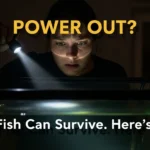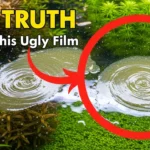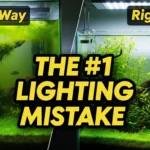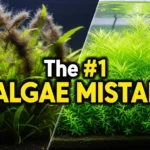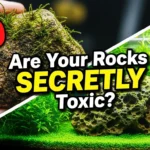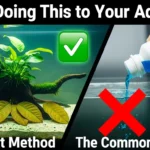It’s the moment every new aquarium owner dreads. You look at your beautiful, tranquil underwater world, and you see it. A fuzzy green patch on the glass. A dusty brown film on your plant leaves. A few dark, hairy tufts on your favorite piece of driftwood. Algae.
Suddenly, this relaxing hobby can feel like a stressful, losing battle. If you’ve searched for a solution, you’ve likely been overwhelmed by a sea of conflicting advice, complicated chemical solutions, and forum posts that leave you with more questions than answers. It’s frustrating, and it’s the number one reason people get discouraged.
I’m here to tell you to put down the scraper for a moment and take a deep breath. After years of building and maintaining algae-free low-tech tanks, I can tell you that the secret to effective aquarium algae control isn’t about scrubbing harder or buying more chemicals. It’s about understanding a simple, powerful philosophy that will change the way you see your tank forever.
The Golden Rule of Algae Control: Algae is a Symptom, Not the Disease
Let me share the single most important lesson you will ever learn in this hobby: Algae is not the problem. It is a symptom of an imbalance in your aquarium.
Think of it like this: a weed doesn’t just appear in a barren desert. It appears where there is a patch of fertile soil and an opportunity to grow. Algae works the same way. It is an opportunistic organism that only takes hold when there is an excess of something in your tank—usually light or nutrients—that your primary plants aren’t using.
The frantic, endless cycle of scraping and scrubbing is just treating the symptom. You’re pulling the weed, but you’re not fixing the fertile soil that allowed it to grow in the first place. The secret to long-term success is to stop fighting the algae and start building a healthy, balanced ecosystem where algae doesn’t get the opportunity to grow.
Finding the Imbalance: The 3 Main Causes of Algae in a Low-Tech Tank
In a low-tech planted tank, almost all algae problems can be traced back to an imbalance in one of three key areas. By playing detective and identifying the root cause, you can solve your algae problem for good.
1. Too Much Light (The #1 Beginner Mistake)
This is, without a doubt, the most common culprit. Beginners often think that more light is always better for plants. In a high-tech, CO2-injected tank, that can be true. But in a low-tech tank, too much light is like pouring gasoline on a fire.
- The Science: Light is the energy source for photosynthesis. If you provide a massive amount of energy (high light intensity or long duration), but your plants don’t have a matching amount of CO2 and nutrients to use that energy, who uses it instead? Algae.
- The Diagnosis: Is your light on for more than 8 hours a day? Is your tank sitting near a window where it gets direct sunlight? Is the light you bought incredibly bright? If you answered yes to any of these, you’ve likely found your imbalance.
- The Fix: This is the easiest fix in the entire hobby. Reduce your lighting period (photoperiod) to 6-8 hours per day. Use a simple outlet timer to make this consistent. If your tank is getting direct sunlight, move it. This single adjustment solves more than half of all beginner algae issues.
2. Too Many Nutrients (Overfeeding & Bioload)
The second major cause of algae is an excess of nutrients in the water, specifically nitrates and phosphates. In a low-tech tank, this almost always comes from one source: too much food.
- The Science: Every flake of uneaten food and every bit of fish waste breaks down and releases ammonia, which is then converted into nitrates. While your plants use nitrates as food, if you are producing them faster than your plants can consume them, you are simply providing a free, all-you-can-eat buffet for algae.
- The Diagnosis: Are you feeding your fish more than they can eat in one minute? Do you see leftover food decaying on the substrate? Is your tank heavily stocked with fish?
- The Fix: Feed your fish less. It’s that simple. Feed them only a tiny pinch once a day. A healthy fish is a slightly hungry fish. Also, be mindful of your tank’s bioload. A properly stocked tank with small, low-waste fish will have a much easier time staying in balance. This is a crucial part of long-term aquarium algae control.
3. Unhealthy Plants (Losing the Competition)
This is the cause that many beginners overlook. Your aquatic plants are your primary partners in the fight against algae.
- The Science: Healthy, growing plants are constantly consuming nutrients from the water. They are in direct competition with algae for the same food source (light, nitrates, phosphates). When your plants are thriving, they effectively starve the algae out, leaving no resources for it to grow. If your plants are unhealthy, melting, or not growing, they stop consuming nutrients, leaving the door wide open for algae to take over.
- The Diagnosis: Are your plant leaves turning yellow or brown? Are they covered in holes? Have they stopped growing completely?
- The Fix: Ensure your plants have what they need to thrive. Are they getting enough light (but not too much)? Do they have a nutrient-rich substrate or root tabs? A healthy plant is the best algae filter you will ever own.
Your Natural Aquarium Algae Control Toolkit: A 3-Step Action Plan
Okay, so you’ve identified the imbalance. Now, how do you deal with the algae that’s already there while your tank re-balances? This is where your natural toolkit comes in.
Step 1: Introduce the “Cleanup Crew”
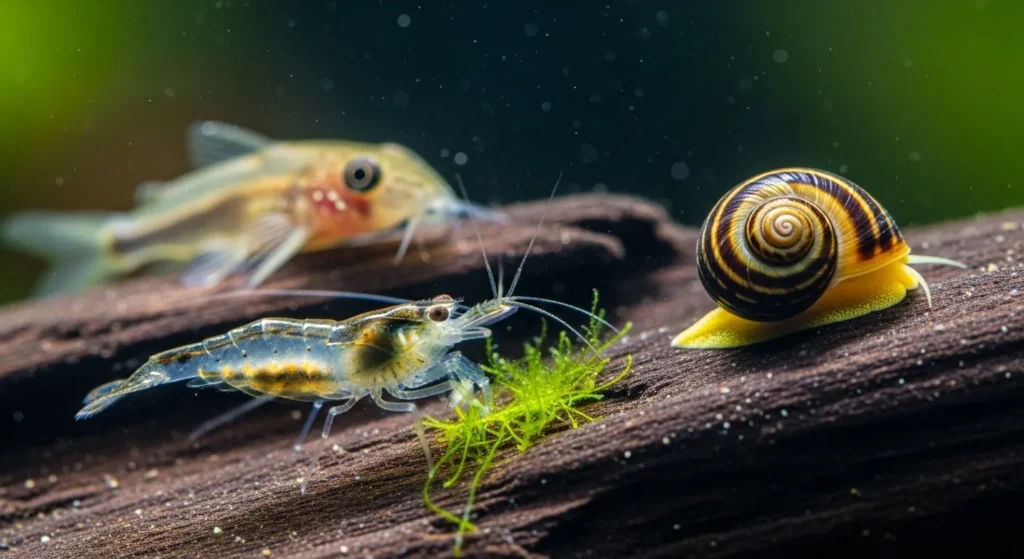
This is the most enjoyable part of any aquarium algae control strategy. A good “cleanup crew” is a team of specialized fish, shrimp, and snails that actively eat algae and waste as part of their natural diet. They are a vital part of a balanced ecosystem.
- Otocinclus Catfish: These small, peaceful catfish are soft green algae and diatom specialists. A small school will happily graze on your plant leaves and glass all day.
- Amano Shrimp: These are the workhorses of the cleanup crew. They are relentless consumers of most types of algae and leftover fish food.
- Nerite Snails: These snails are beautiful and effective. They are fantastic at cleaning glass, rocks, and driftwood, and they have a huge advantage: their eggs cannot hatch in freshwater, so they will never overpopulate your tank.
By adding a good cleanup crew, you are creating a 24/7 maintenance team. This is a perfect opportunity to learn more about the best fish for a low-tech planted tank.
Step 2: Master Manual Removal
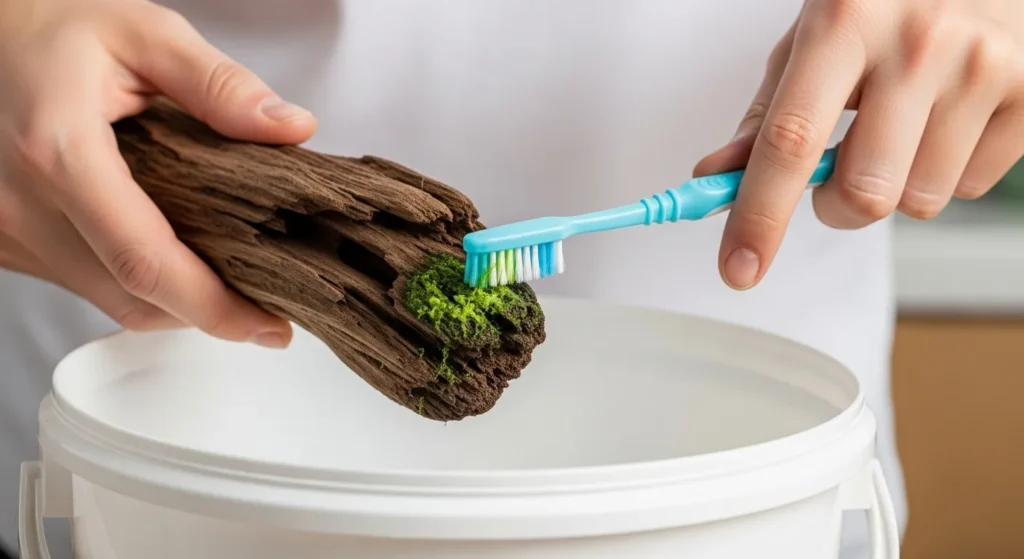
While your cleanup crew gets to work, you can speed up the process with some simple manual removal.
- For Glass: Use an algae scraper with a plastic blade or an old credit card to easily scrape off green spot algae.
- For Rocks & Driftwood: A new, dedicated toothbrush is your best friend. Use it to scrub off fuzzy or stubborn algae during a water change.
- For Plant Leaves: Gently rub the leaves between your thumb and forefinger to dislodge soft algae.
- For Stringy Algae: Twirl it around your toothbrush or a wooden skewer like spaghetti to remove it in clumps.
Step 3: The Role of Sensible Water Changes
Water changes are a great tool, but it’s important to understand their role. A 20-30% weekly water change helps to physically remove free-floating algae spores and, more importantly, it helps to “reset” the nutrient levels in your water, diluting the excess food that algae is feeding on.
Know Your Enemy: A Quick Guide to Common Algae Types
Understanding what type of algae you have can help you pinpoint the imbalance even faster.
| Algae Type | Appearance | Common Cause |
| Brown Diatoms | A dusty, brown film that wipes off easily. | Very common in new tanks (first 1-3 months); silicate imbalance. |
| Green Spot Algae | Tiny, hard, circular green dots on glass and slow-growing leaves. | Often a sign of too much light and low phosphates. |
| Black Beard Algae | Tough, dark, hairy tufts that grow on hardscape and plant edges. | The toughest to beat; often linked to inconsistent CO2 (less common in low-tech) or high organic waste. |
Export to Sheets
A Word on Algaecides (Chemicals): Why They Are a Last Resort
You will see bottles of “Algaefix” and other chemical algaecides at the store. They promise a quick, easy solution. I am telling you now: avoid them.
These chemicals are a risky, temporary fix that fails to address the root cause of your problem—the imbalance. They are indiscriminate killers. They can harm or kill your sensitive fish, they are often lethal to invertebrates like shrimp and snails, and they can damage your delicate aquatic plants.
Using chemicals is like using a sledgehammer to hang a picture frame. It’s the wrong tool for the job. The natural, ecosystem-based approach to aquarium algae control is safer, more effective in the long run, and far more rewarding.
Conclusion: You Are an Ecosystem Gardener
The appearance of algae is not a sign of failure. It is a sign from your aquarium that something is out of balance. It’s a call for you to become a detective, to observe your little world, and to make small, gentle adjustments.
By controlling your light, managing your nutrients, and promoting healthy plant growth, you create an environment where algae simply can’t compete. You are not an algae scrubber; you are an ecosystem gardener. Embrace this philosophy, and you will not only beat your algae problem, but you will also create a truly thriving, stable, and beautiful underwater world. This is the true path to successful aquarium algae control.

Daniel Ravera is the founder of AquaInitium, where he shares insights gained from over a decade of hands-on aquascaping. His expertise lies in the low-tech, ecosystem-first method—a philosophy he adopted after experiencing the common frustrations of algae and instability himself. As an authority in the beginner aquascaping niche, Daniel provides clear, trustworthy advice to help you build a beautiful, stable aquarium and avoid the costly mistakes he learned the hard way.


